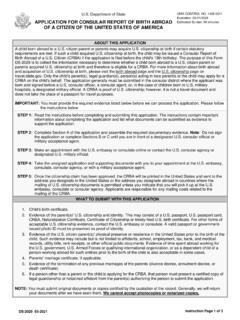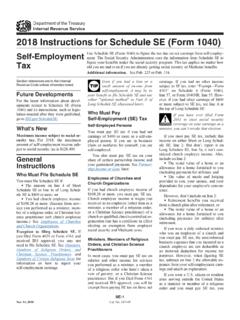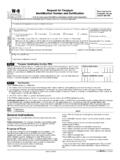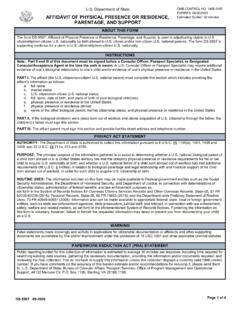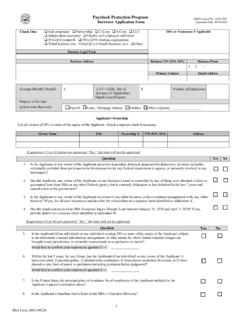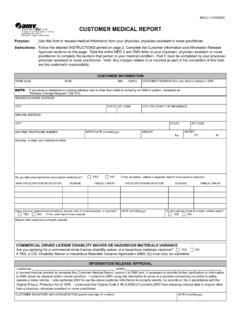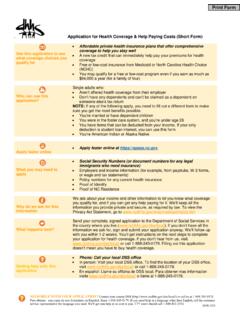Transcription of Guidance for Financial Institutions Requesting the Form ...
1 Guidance for Financial Institutions Requesting the form The Following pages contain an example of a form that could be used to collect data from Controlling Persons in relation to the CRS. This form has been devised following the input of various industry experts on CRS, as an example, as to what could be used in order to attempt to create some market consistency and assist Financial Institutions in developing validation systems. This is an example of the type of form that could be used by a Financial Institution. It should not be seen as a mandatory form . Each Financial Institution is free to use its own form , but as a minimum a Financial Institution should collect the mandatory data detailed in the CRS commentary in accordance with local rules and Guidance . Each Financial Institution also may need to modify this form based on local rules.
2 For example, if the Controlling Person is not reportable, it may not be required or permissible to collect the tax identifying number or the date of birth, unless local rules permit the collection of that information under the wider approach . If a Financial Institution is not permitted to collect tax identifying number and date of birth with respect to jurisdictions that are not reportable, it may be required to re-document Controlling Persons as new jurisdictions are added to the list of Reportable Jurisdictions. In addition, in some jurisdictions certain Financial Institutions may be required to collect the Controlling Person s place of birth. In other jurisdictions or for other Financial Institutions , it may not be required, or not legally permissible, to collect this information, and in this case the place of birth fields should be deleted.
3 If place of birth is required to be collected, the Financial Institution must collect both the city or town and the country of birth. Similarly, in some jurisdictions, Financial Institutions may be required to collect and report the type of Controlling Person, and type of Controlling Person is included in the CRS schema. In other jurisdictions, however, type of Controlling Person may not be required to be reported, and it may not be legally permissible for a Financial Institution to collect such information. Fields marked with a * are mandatory, subject to variations in local rules, as discussed above. Financial Institutions may also be able to collect the information required to be reported in another way ( , other than on the self-certification). For a self-certification to be valid, however, it generally must contain the Account Holder s (i) name, (ii) residence address, (iii) jurisdiction(s) of residence for tax purposes, (iv) tax identifying number for each Reportable Jurisdiction, and (v) date of birth.
4 Jurisdictions adopting the wider approach may require that the self-certification include a tax identifying number for each jurisdiction of residence (rather than for each Reportable Jurisdiction). In Part 4 a Financial Institution should choose the time-limits applicable to its own procedures, (for example 30 days ). In Part 4, please also note that the CRS does not require a Financial Institution to collect a certified copy of the power of attorney; the form includes this language as optional on the part of the Financial Institution. Page 2 of 11 If a Financial Institution requests the form due to a change in circumstances or because indicia of reportable status is associated with the account, the Financial Institution may be required to obtain Documentary Evidence (as defined in the CRS and Commentary) that (i) confirms that the Controlling Person is resident in a jurisdiction other than the relevant Reportable Jurisdiction; (ii) contains a current residence address outside the relevant Reportable Jurisdiction; or (iii) is issued by an authorised government body of a jurisdiction other than the relevant Reportable Jurisdiction.
5 If a Financial Institution knows or has reason to know that a self-certification is incorrect, it is expected that in the course of the account opening procedures the Reporting Financial Institution would obtain either (i) a valid self-certification, or (ii) a reasonable explanation and documentation (as appropriate) supporting the reasonableness of the self-certification (and retain a copy or a notation of such explanation and documentation). Page 3 of 11 Controlling Person tax residency self-certification form INSTRUCTIONS CRS - CP Please read these instructions before completing the form . [Insert: applicable national regulations or text Regulations based on the OECD Common Reporting Standard ( CRS ) ] require [insert Financial Institutions or insert the individual Financial Institution s name] to collect and report certain information about an account holder s tax residence.
6 Each jurisdiction has its own rules for defining tax residence, and jurisdictions have provided information on how to determine if you are resident in the jurisdiction on the OECD automatic exchange of information portal. In general, you will find that tax residence is the country/jurisdiction in which you live. Special circumstances may cause you to be resident elsewhere or resident in more than one country/jurisdiction at the same time (dual residency). If you are a citizen or tax resident under law, you should indicate that you are a tax resident on this form and you may also need to fill in an IRS W-9 form . If your tax residence (or the Controlling Person, if you are completing the form on their behalf) is located outside [insert : name of country or following text the country/jurisdiction where the FI is maintaining the account is located ], we may be legally obliged to pass on the information in this form and other Financial information with respect to your Financial accounts to [insert: name of local tax authorities ( HMRC) or text the tax authorities in the country where the FI is located ] and they may exchange this information with tax authorities of another jurisdiction or jurisdictions pursuant to intergovernmental agreements to exchange Financial account information.
7 You can find summaries of defined terms such as an account holder, Controlling Person, and other terms, in the Appendix. This form will remain valid unless there is a change in circumstances relating to information, such as the Controlling Person s tax status or other mandatory field information, that makes this form incorrect or incomplete. In that case you must notify us and provide an updated self-certification. This form is intended to request information consistent with local law requirements. Please fill in this form if the account holder is a Passive NFE, or an Investment Entity located in a Non-Participating Jurisdiction and managed by another Financial Institution. For joint or multiple controlling persons use a separate form for each controlling person. Where you need to self-certify on behalf of an entity account holder, do not use this form .
8 Instead, you will need an Entity tax residency self-certification. Similarly, if you re an individual account holder, sole trader or sole proprietor, then please complete an Individual tax residency self-certification. If you re filling in this form on behalf of a controlling person, Please tell us in what capacity you re signing in Part 4. For example you may be the Passive NFE Account Holder, or completing the form under a power of attorney. As a Financial institution, we are not allowed to give tax advice. Your tax adviser may be able to assist you in answering specific questions on this form . Your domestic tax authority can provide Guidance regarding how to determine your tax status. You can also find out more, including a list of jurisdictions that have signed agreements to automatically exchange information, along with details about the information being requested, on the OECD automatic exchange of information portal.
9 Page 4 of 11 Controlling Person tax residency self-certification form (please complete Parts 1-3 in BLOCK CAPITALS) Part 1 Identification of a Controlling Person A. Name of Controlling Person: Family Name or Surname(s): * Title: First or Given Name: * Middle Name(s): B. Current Residence Address: Line 1 ( House/Apt/Suite Name, Number, Street, if any)* Line 2 ( Town/City/Province/County/State)* Country:* Postal Code/ZIP Code (if any):* C. Mailing Address: (please complete if Section B above not completed) Line 1 ( House/Apt/Suite Name, Number, Street) Line 2 ( Town/City/Province/County/State) Country: Postal Code/ZIP code: D. Date of birth*(dd/mm/yyyy) E. Place of birth Town or City of Birth* Country of Birth* F. Please enter the legal name of the relevant Entity Account Holder(s) of which you are a Controlling Person Legal name of Entity 1 Legal name of Entity 2 Legal name of Entity 3 Page 5 of 11 Part 2 Country/Jurisdiction of Residence for Tax Purposes and related Taxpayer Identification Number or functional equivalent* ( TIN ) (See Appendix) Please complete the following table indicating (i) where the Controlling Person is tax resident; (ii) the Controlling Person s TIN for each country/jurisdiction indicated; and, (iii) if the Controlling Person is a tax resident in a country/jurisdiction that is a Reportable Jurisdiction(s) then please also complete Part 3 Type of Controlling Person.
10 Countries/Jurisdictions adopting the wider approach may require that the self-certification include a tax identifying number for each country/jurisdiction of residence (rather than for each Reportable Jurisdiction). (You can also find out more about whether a country/jurisdiction is a Reportable Jurisdiction on the OECD automatic exchange of information portal). If the Controlling Person is tax resident in more than three countries/jurisdictions, please use a separate sheet If a TIN is unavailable please provide the appropriate reason A, B or C: Reason A - The country/jurisdiction where the Controlling Person is resident does not issue TINs to its residents Reason B - The Account Holder is otherwise unable to obtain a TIN or equivalent number (Please explain why you are unable to obtain a TIN in the below table if you have selected this reason) Reason C -No TIN is required.










